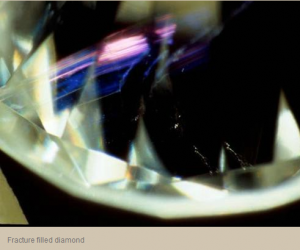 A justly irate consumer recently illustrated for pearl and bead stringers, jewelers and others in the trade that honesty is always the best policy. Always.
A justly irate consumer recently illustrated for pearl and bead stringers, jewelers and others in the trade that honesty is always the best policy. Always.
This person had bought a diamond from a New York diamond dealer. Although she was told the diamond was clarity enhanced, she was not told that it was fracture filled.
Technically, fracturing filling is a clarity enhancement. But, and this is a big but, fracture filling refers to a process whereby a crack or fracture in the diamond is filled with glass of approximately the same refractive index as diamond. The problem with the procedure is that it will discolor and can melt during the jewelry repair process. Moreover, the stone isn’t as durable as non-fractured diamonds.
Simple common sense would suggest that the consumer should have been told that the diamond was cracked and filled. The process has been around for more than 30 years and is well accepted for enhancing lower quality stones.
If common sense didn’t persuade the seller, the Federal Trade Commission should have. It requires that fracture filling must be disclosed. So the company was legally obligated to reveal the treatment.
To add insult to injury, the consumer was given a wildly inaccurate appraisal for the diamond, including an overestimate of its carat weight.
When she complained to the company, in a superb example of customer service she was told fracture filling “isn’t a big deal.”
Enraged, she has taken to the internet and posted complaints at Yelp, pissedconsumer.com, complaintboard.com and on the company’s Google places profile.
Good for her.
This is a textbook example of why the trade is often regarded with suspicion.
In the sales process, it’s natural to want to de-emphasize a perceived negative about the product or service being sold. But in my twenty five years in the trade, I’ve learned that consumers want to know everything about the piece they are buying and that they are very rarely put off by learning the materials are enhanced.
There is a corollary to this and that is that pearl and bead stringers, bench jewelers and salespeople must take the time to learn about the materials they are selling.
All too often they don’t. In a very recent example, I ran into someone selling “real” – by which she meant untreated – amber. She didn’t know that the star bursts or spangles in the beads signified the amber had been melted and molded. I don’t believe this young woman meant to deceive the buyer, but the net result was the same. The consumer didn’t get what he thought he was buying.
It should also be pointed out that knowing your materials protects you. Although I ran a gallery, not a jewelry store, people often approached me for help with jewelry repair or redesign and usually I was happy to help. However, years ago, a very unpleasant man approached me about setting a diamond he’d bought for his wife. It was a 25 pointer, a small diamond, and as he ranted about how he could be sure I’d return the same diamond to him I looked at it under 10x magnification. Sure enough, there it was, the distinctive flash signifying a fracture filled diamond.
I did not accept his business and did not mention to him that his diamond was fractured filled. That was a snap judgment and perhaps I should have.
The point is that had I accepted his business without knowing the diamond was fracture filled, I really cringe to think of the accusations — and potential lawsuit — that would have come my way.
So, know your materials and don’t be afraid to disclose enhancements. Your customers will thank and trust you and not incidentally you’ll protect yourself.
By the way, if you want to read her complaint, here is the link to pissedconsumer.com

